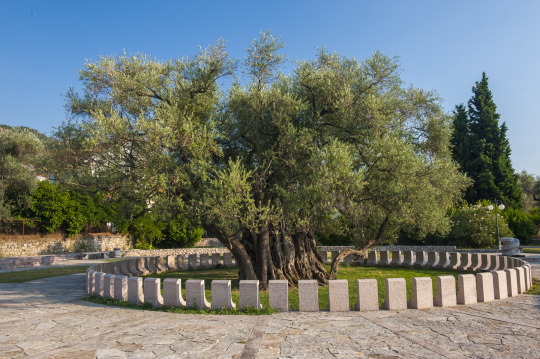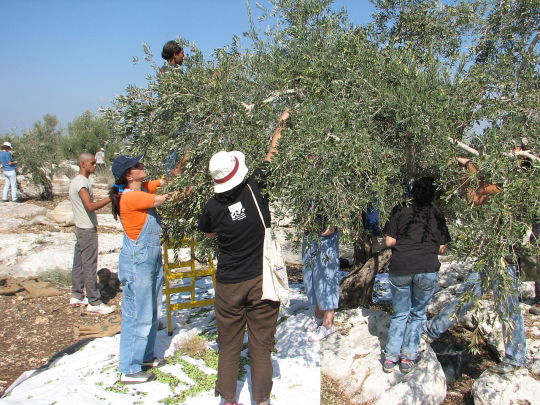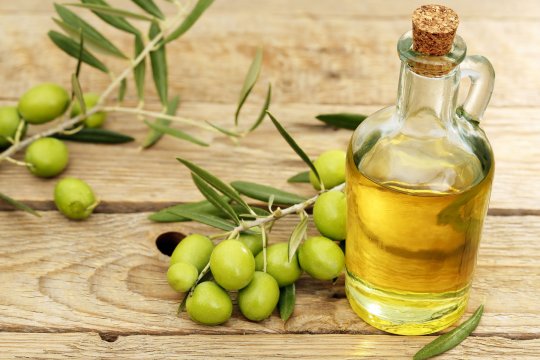#Mirovica
Text
Olives – A Thousand-year-old Trees

Old Lady from Mirovica (near Bar)
Natural monument protected by law since 1957.
Over 2000 years old Olive Tree and one of the oldest in this part of Europe.
When this ancient plant offered its first branch and was slowly growing up into a young tree, the lions were slowly disappearing from the territory of Western Europe, the Roman Empire was at its peak, Arena in Pula was built and two major world religions emerged – Buddhism and Christianity.
For more than 2000 years, old olive has witnessed history. Its exceptionally long life, which continues to be crowned each year with the fruit of exceptional quality, makes this plant one of the oldest in the world.
When I visited Old Bar on the Montenegrin seaside, the townspeople proudly showed me their olive groves on the hills around the town. Those are the gardens of a row of generations. Most of the olive trees in this area, and in the whole Montenegrin seaside are a hundred, two hundred, or even five hundred years old, and some are older still.
One should know that an olive tree can live for a thousand years and sometimes even longer. The one which is over two thousand years old dwells by the road leading from Bar to Ulcinj! Experts have confirmed its age and marked it as the oldest tree in Europe. It is huge indeed, with a trunk about ten meters in circumference. This olive, as a unique tree on the continent, is fenced and under protection of the state. Tourists gladly visit this olive and take photos under its treetop. On its still green branches fruits are sparse, but it is, still, the most expensive tree in Europe. Experts from Rome used to offer as much as a few million lira for it. They planned to root it out completely and take to Rome in order to decorate and enrich a botanical garden of their own.

But this old “lady” is not only olive tree here; there are many more of them, and all provide shelter from the hot and steamy summer days under their dense crowns, both for tourists and local people. Old olive groves often inspire poets and painters who come to the Montenegrin seaside in the summer time. They sing to them, make paintings and take these canvases with them as souvenirs. In fact, many of old olive trees are songs, stories and memories themselves, both of their own and of the human past. Very often, a hundred, five-hundred, and a thousand-year-old olive trees receive personal names: Đuro’s, Radun’s, Todor’s, Risto’s, Periša’s. They are named thus after the individuals who planted them: Đuro, Radun, Todor… Who knows when? They planted olives on hills, stone terraces and valleys and these long-lasting trees have preserved their names in return. That is how olives became the monuments of their past owners and it seems as if they are telling the stories of their grandfathers and great-grandfathers to the younger generations. That fact is that a man who plants an olive does not do it for himself but for his sons, grandsons and great-grandchildren. Olives grow slowly, and one has to wait long for them to fruit. Its fruits begin to grow and mature after the first thirteen years of a tree’s life.
As years go by, the tree develops, bearing constantly richer crops. It grows wider, and puts forth new branches. They give the best crop when they are about a hundred years old. But fruits grow and mature even at two hundred years and more. And, eventually, years and centuries pass by, the olives get old, and only few spring flowers and autumn fruits can be found in their branches.
The stories and legends about olive growing are told even today. They are usually connected to encounters and meetings of boy and girls. A story tells that in the medieval times there was a law preventing a young man from getting married unless he had planted at least ten olives. That was the reason for which boys grew these long-living trees with special care and attention – they cherished them, made small terraces around their roots, dug up the soil, fertilized it. In winter they wrapped up young plants with linen or straw to protect them from the frost that used to come down from the hills of Lovćen and Rumija. It was customary to plant two seedlings in the ground. Even today, when you go through these olive groves you often see two olives growing one by the other. At their treetops the branches are intertwined so that they seem to hug each other. This possibly explains why many people call the olive the fruit of love and future. Olive trees have always been believed to bring their owners not only fruits, but also love, good luck and longevity.

The symbolism of an olive branch dates back as far as the 5th Century, and over time has held significance in a multitude of cultures. This week’s top 5 introduces the various meanings behind our beloved olive trees.
VICTORY
Even though the origins of an olive branch as a symbol of peace lie in ancient Greek mythology, its symbol of victory was also prolific during the same period. It was Athena’s victory over Poseiden when she was awarded possession of Athens by the court of the gods & goddesses after she planted the first olive tree. Such a gift to the land was far better a gesture than that of Poseidon’s dramatic attempts.
WISDOM
Furthermore, as the goddess of wisdom in ancient Greek mythology, Athena’s gesture to claim and successful acquire the possession of Athens through planting the first olive tree, has since associated the olive branch with The Tree of Wisdom.
PEACE
With a strong symbolism of peace in Christianity, the olive branch was noted for it’s same significance across many other cultures & religions. Our favourite peace signifier of the olive branch is that which originates from times of war. Because of it’s slow growth and not being cultivated during war time, olive trees were considered as “peace-time trees”.
FERTILITY
In folk tradition of Greek medicine olive oil was considered to be an aphrodisiac. The new year’s olive oil harvest was gifted in the shape of bread to young couples as an antidote to sterility.
HOPE
In the Old Testament a dove returns to Noah’s ark with an olive branch, as a symbol of hope to the people at the end of the great flood.
Source: LIKE MONTENEGRO
http://www.likemontenegro.me/old-lady-from-mirovica/
This noble tree is grown not only on the Montenegrin Coast but also all over the Mediterranean Shore. Sailors used to tell me that chains of olive trees create a huge green garland around the azure seawater all the way from Egypt to Istria. However, in the northern part of the Adriatic Coast olives are far less grown than in the southern, which is conditioned by the air temperature. Regions with hot summers and mild winters provide the best conditions for olive growing. Therefore, the most convenient climate for them is to the south of Dubrovnik, and the real olive “homeland” stretches exactly across the Montenegrin Shore.
This area has not only a suitable climate, but also and ideal soil structure for them. Olives prefer mild clay and loose soil containing higher amount of limestone and this is exactly the composition of Montenegrin seaside land.
According to statistics, there are over 550,000 olive trees on the Montenegrin coast. This means that the olive production is the most widespread fruit-growing business in this region. Ulcinj’s plantation has the best olive groves constantly records bumper crops. When I visited this property, the olive picking was in its prime. The pickers were mostly girls and young women.
Olive picking in this area is much like grape-picking at vine-growing regions. The only difference is that men take a minor role. They load bags and panniers, and after carrying their burdens from the olive groves, load them onto the donkeys, horses or vehicles which will carry them to the ‘ransom stations’.

Israeli and Palestinian olive harvesters in the village of Qafin, northern West Bank, Palestine
Author: Orrling, Source: Commons.Wikimedia
The picking season lasts a long time, sometimes running from the middle of September to the end of February, especially when weather forecast is for sunny autumn and mild winter. Slow picking makes for a higher income, because it allows the fruit to mature gradually, as is natural.
But, when the olive yield is abundant all this effort is repaid tenfold. From one hundred kilograms of olives 20 kilograms of first class oil can be extracted. Unrefined olive is used for various spices and as winter food. The sorts most often used for this purpose are drobnica and oskulenka olives, while the žutica, oblica and levantinka varieties are better for oil. Oblica and žutica are the most prolific, and for this reason they are most extensively grown. It is reckoned that from the olive groves of the Montenegrin seaside about one million kilograms of oil are extracted each year.

This figure best shows how much benefit the population can gain from this ancient fruit. For this reason extension and improvement of olive groves are permanently under way. Community farms and agriculture cooperatives, as well as individual farms, progressively apply scientific farming methods in cultivation of olive groves are permanently under way. Community farms and agriculture cooperatives, as well as individual farms, progressively apply scientific farming methods in cultivation of olive groves, particularly in Ulcinj and Bar districts.
Text taken from: Traveling Through Montenegro, Draško Šćekić
#olive#olive tree#maslina#ulje#maslinovo ulje#olive oil#victory#wisdom#peace#fertility#love#montenegro#bar#old lady#Mirovica#Old Bar#Crna Gora#Stara Maslina
1 note
·
View note
Photo

Porodicna vecera 🤗🤗🤗😍😍😍 #amigas #dinnertime #happytogether #havingfun #foodporn (at Etno restoran "Mirovica")
1 note
·
View note
Text
Син Игора Мировића, наследник прошлости која траје
Син Игора Мировића, наследник прошлости која траје http://www.vaseljenska.com/drustvo/hronika/sin-igora-mirovica-naslednik-proslosti-koja-traje/
0 notes